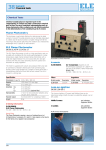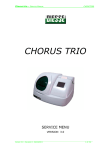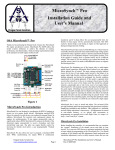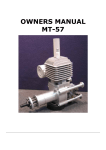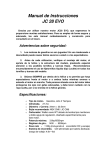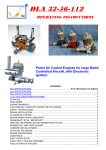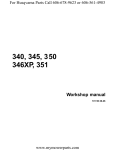Download JC 30EVO User Manual SPECIFICATIONS: Operating Instructions
Transcript
JC 30EVO User Manual Model Airplane Engines SPECIFICATIONS: 2 Stroke air cooled single cylinder, single ring. Walbro membrane pump carburetor with dual needles and manual choke Automatic advancing electronic ignition Output Power: Idle Speed: Maximum Speed: Displacement: Bore and Stroke: Weight: Engine Exhaust – Ignition - 4.0 hp at 9000rpm 1300 rpm 9000rpm 30 cc 36mm×30mm 920g 90g 120g Propeller: 17-8 Ignition Battery: 4.8 to 6.0 Volts, typically 1200Mah Replacement Spark plug: NGK CM-6 or equivalent to 20-6 Operating Instructions Thank you for purchasing our JC30EVO, we hope it will bring you many hours of enjoyment. It is important to familiarize yourself with these safety precautions, as well as the operating instructions - these engines can cause serious injury to people and animals. This will help you avoid injury or harm to yourself, other persons or animals. JC ENGINE POWER CO.,LTD will not be held responsible for any loss, injury or damage resulting from inappropriate use of its products - you are responsible for the safe operation of your equipment. Safety Instructions We recommend that you never operate the motor or fly alone. Always be very aware of the propeller and its dangers while operating the motor. Avoid distractions and loose clothing. It is always a good idea to paint the propeller tips white or yellow - propellers are near invisible when spinning. Loose items or material can be drawn into the turning prop causing injury or damage. Always operate the motor in an open or well ventilated area. These motors develop substantial thrust levels so ensure that the aircraft or test bench is properly secured when starting or operating the motor. Regularly check the motor and propeller mounting bolts. It may be wise to wear ear protection during extended ground running. Always keep people and animals behind the propeller arc, not in front or to the side of the propeller and keep spectators at a safe distance away when operating the motor. Stop the motor before making any adjustments. Always use the correct length propeller bolts, not too long or too short. Spinner cones must never touch the propeller - maintain at least a 1mm clearance all around. We recommend the use of an ignition kill switch to stop the motor as well as setting up the carburetor linkage so that the motor will stop when the throttle and trim is completely closed Petrol is flammable. Be aware of potential sources of sparks from electrical contacts such as fuel pumps, battery chargers, etc. Store fuel in appropriate containers and mix or use in well ventilated areas. The ignition system develops extremely high voltage. Do not touch it during operation. Primed engines have been known to fire (from standstill) when the ignition is switched on. Please stay clear of the propeller when switching on the ignition and always ensure that the ignition is turned off when priming, choking, changing propellers or storing. Warranty The true spirit of the JC Engines warranty endeavours to fairly resolve any matters that impact on the proper operation or performance of the engine and ignition system, as may result from defective materials or workmanship from the manufacturer. This intent may be compromised by the very nature of the application of model airplane engines, whereby various forms of harm are possible that are not related to defective workmanship and /or materials on the part of the manufacturer. This would include crash damage, incorrect fuel/ lubricant or mix ratio; incorrect mixture settings; incorrect propeller selection, inadequate cooling, incorrect voltages for the ignition, etc. Disassembly and /or modifications to the engine or ignition system will void the warranty. The warranty does not cover damage resulting from a mishap, or damage caused by incorrect operation of the product in terms of the operating instructions, or shipping costs associated with any warranty service. Mounting the Engine Whereas the threads in the engine stand-offs and prop driver are perfectly adequate for the purpose, they are easily damaged by excessive tightening or by cross threading. Take care when starting the bolts to ensure that they engage the threads properly and make use of a suitable thread lock rather than applying excessive torque. LOCTITE 242 Blue or an equivalent thread lock is preferred. Be aware that products such as LOCTITE RED 262; 272; 277 are considered permanent and require specl treatment to remove.ial Propeller bolts should be applied without thread lock as they should be re-tightened or checked regularly. Similarly, bolts passing through a wooden firewall should be checked regularly. JC Engines are not sensitive to orientation and can thus be mounted in the position best suited to the particular installation, cowl shape, fuel tank location, etc. JC Engines are not sensitive to fuel tank position, thus the fuel tank can be located anywhere in the model to suite the available space, CG, scale detail, etc. It is however important to point out that fuel may siphon from the fuel tank, out of the carburetor (overflow /breather) whilst the engine is not operating if the fuel level (in the tank) is higher than the fuel inlet on the carburetor (overflow /breather) when the model is parked or stored. This could be a fire hazard and or cause damage to the model, the more so if the engine is mounted with the carburetor behind the firewall (see below). Single cylinder JC Engines feature rear induction in the interest of performance and a smaller frontal profile. you may mounted directly onto the firewall (with a suitably sized hole in the firewall) placing the carburetor behind the firewall. Alternatively, the engine can be mounted onto the firewall by means of the engine mount stand-offs provided. Either way, ensure a clear passage for induction air to the carburetor. These instructions do not attempt to address the integrity of the airframe structure other than to urge careful and regular inspection of the relevant materials and bonds. It is important that the mounting plane (surface) is the same for all four attachment points, i.e. the firewall is perfectly flat. Cap head bolts and penny washers are provided for firewall mounting. There is approx 20mm of thread in each engine mount pillar and 25mm cap head bolts are provided. This allows up to 10mm for the firewall, washers and spacers. Please ensure that these bolts do NOT bottom out in the mounting pillars, the bolts will not be holding the engine securely and the threads may be damaged. Ensure that at least 6 mm of the bolt threads penetrate the mounting pillars, 8mm is better. Longer or shorter bolts are available. Ignition Module: Mount the ignition module in the fuselage or under the cowl. Thick (two layers) double sided tape or a foam pad will provide vibration isolation and plastic cable ties should complete the task either way. Do not hard mount. Use the same gauge wire (or larger) as used on the red and black power leads on the ignition module, all the way to the battery pack. Keep wire lengths to a minimum. Use a high quality switch such as a Futaba or JR switch. Low cost budget switches are not recommended. There are differing views regarding the use of a 5 cell ignition pack, All testing with a regular NiCad or NiMH 4 cell pack has produced satisfactory results but there may be circumstances where a higher voltage is advantageous. A 1,500mah pack is adequate for a typical flying session. Please use the spiral wrap provided, especially on the HT plug lead to prevent rubbing against fiberglass or other sharp edges. Damage to the wire mesh shielding has been known to cause erratic engine operation as well as radio interference. Whereas the propeller should be treated as potentially live and dangerous at all times, it is uncommon for an engine with this ignition to backfire, snap or bite. The ignition will trigger a spark irrespective of the speed that the magnet passes the Hall Effect sensor, so it is not necessary to flip the prop with all your might, just flip it through compression and stay clear. Pull the plug cap off straight when removing, do not pull on the shielded ignition wires. The spark plug cap must have the split retainer ring fitted, flying without this retainer can cause RFI and unreliable operation. There are mixed views regarding the safe proximity of the ignition components (including switch and battery) to the receiver and associated components. Whereas we have a documented case where the ignition and receiver battery packs were actually placed together in the tank bay (CG consideration) on a 35 MHz installation without any problems, we do suggest maintaining whatever separation may be available between the ignition and components and the receiver and components. Spark Plug: JC Engines are supplied Rcexl CM 6 spark plugs. We have seen plugs of low quality on other engines, but we have had no problems with the supplied plugs on any of the JC Engines, despite many hours of operation. Some experienced modelers recommend the use of NGK CM-6, these are available from your distributor. Fuel and Oil Mix Just about any clean fresh petrol without moisture will work in your JC engine, but unleaded petrol is recommended. Some flyers have used Avgas without any problems, but this offers no advantage, is more costly and more difficult to locate petrol is available on every other street corner. We recommend filtering your fuel between your fuel container and your fuel tank, plus a high flow filter, or clunk/filter, between the tank and motor. Ensure that the tank is well vented and that the clunk moves freely without snagging on the back of the tank. Use of any other fuel or additives such as methanol, nitro formulas are not necessary and may harm the motor. Do not use any silicon tubing or sealers anywhere in the fuel system as petrol will break it down causing leaks and poor engine operation. For Break-in, we recommend a known brand of petroleum-based 2 stroke lawn mower oil. Use of high quality synthetic oils will only prolong the running in time on a JC engine, in particular those engines with two large piston rings. Outboard oil is not recommended for use in air-cooled engines. A mix ratio of 30:1 is recommended for the initial beak in period (aprox. 10 litres of fuel), changing to 40:1 mix for a further 10 litres. For best results, allow the engine to run between 6,500 and 7,000 rpm with adequate cooling during break in and make sure that the engine is not operating on the lean side. Thereafter, continue operating on the 40:1 mineral oil mix or switch to one of the high performance two stroke oils for air cooled engines and mix according the oil manufacturer’s instructions. The engine should be set on peak. Avoid the tendency to run rich as per glow motors, this only serves to foul the plug and carbon up the cylinder. Break In The JC 30EVO have single piston rings and will reward proper running in with good performance and a substantially longer life. We don’t believe in lengthy bench running and would far rather see the engine flying at varying throttle settings but not subjected to hard flying for the first two hours, that is really only eight 15 minute flights. Propellers Always check the prop bolts and inspect your prop and spinner before each flight. The bolts should be checked for correct tightness and not tightened more and more each time. While special break-in props are not required, avoid loading down the engine during the break-in period, as above, let the engine spool up. The safest way to drill mounting holes in a propeller is to use a drill guide for your engine. The next best is to use a drill press, using the prop washer as a guide. Drill from the back of the propeller to ensure that the exit holes are perfectly in line with the associated holes in the prop hub. Bear in mind that multi bolt hubs have a central shaft for accurate propeller location, the mounting bolts are there to keep the prop on the engine and transfer torque. If the prop does not track, replace it or attempt to reshape the seat area – do not crush the prop in an effort to correct the tracking by inconsistent torque on the bolts. Starting Only after carefully checking over your airplane and engine, including the recommended range check for your equipment – then fuel up. An informed helper is always a good idea. From cold (first start of the day): Close the choke and open the throttle approx 50%. Turn the ignition module on and start flipping the propeller. This will only consume a minute or so of battery but it will prevent flooding the motor. Flip the motor until it “barks” or even runs for a few seconds. Open the choke, set the throttle to a fast idle and flip the motor until it starts. If it is a cold day and /or the motor has not run for a while, it may be necessary to repeat the above two steps. Let the engine warm up for 30 seconds or so before advancing the throttle. Subsequent starts on the day generally do not need any choking. Be alert to flooding – if the engines becomes stubborn and will not bark or run, it may be flooded. Shut off the fuel supply by pinching the fuel line (or removing it from the carb) and flipping with the choke closed until it fires and runs. Let it run dry, then start again. The spark plug can also be removed and dried to check if it was flooded and to speed the drying out process. Needle Adjustments The needle closest to the firewall (H) is the high speed needle, the other one (L) is the low speed needle. Turning the needles clockwise “leans” the fuel mixture (reduces fuel flow) and turning the needles counter-clockwise “richens” the fuel mixture (increases fuel flow), just like a shower tap. Settings will vary with altitude, temperature, humidity, fuel, carburetor variances, etc., but a safe starting point would be to close both needles carefully (Don’t tighten a needle hard, it will damage the seat), then open 1½ turns on the L needle and 1¾ turns on the H needle. There is an interaction between the H and L needles so they must be set in sympathy with each other. In brief, after the engine has warmed up and you are sure it is secure, run the motor at full throttle and listen, the engine should be burbling (running rich). If not, open the H needle slowly until the revs drop off (rich). Then slowly screw in (clockwise) the needle and listen as the engine runs progressively faster and smoother. At some point it will be nice and smooth and really pumping, then start to sag (lean), you have just gone through peak. Stop immediately and open the H needle until the engine passes over peak and just starts to fall off (rich) again. Leave the H needle for now. With the engine at its slowest reliable idle, open the throttle briskly. The engine should throttle up nicely – if so start leaning (clockwise) the L needle 1/8 turn at a time until the engine hesitates /stumbles when opened. The L needle is now too lean, open it (anti-clockwise) 1/8 turn and try again until the engine throttles up smartly without stumbling. Each time the L needle is closed a bit, the engine will idle faster, bring it back down with the mechanical idle stop. Now go back to full taps for few seconds and reset the H needle for just-on-peak – then back to the L needle for a steady idle. Set the mechanical idle stop for a reliable idle (1,500 – 1,700 rpm) Listen to the engine during flight – if it appears to sag off during full throttle flight (maybe in a climb), land without delay and richen (anti-clockwise) the H needle1/8 turn. If the engine burbles a bit in the mid-range, the L needle may need to be closed a bit. Check again that the engine does not stumble when throttled up smartly (lean on the L needle). Trouble Shooting Motor won’t start: Flooding: - Over choking can cause flooding. Clear as above. Low ignition battery voltage - check battery voltage (should be at least 5.0+ volts) as well as all ignition connections, wiring, and switches. Check fuel flow and look for kinks, pin holes or other damage. Does fuel move toward the carburetor when the prop is flipped with the choke closed? If not, is the choke butterfly closing completely? Is the carburetor or carburetor mount loose causing an air leak? Is the throttle set at idle or slightly higher after engine “barks” and choke is opened?








